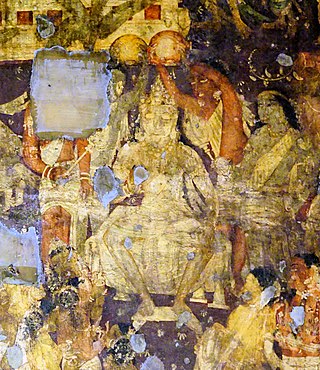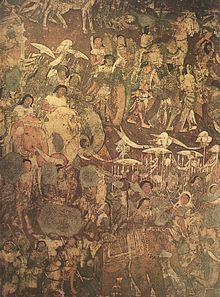
The Sinhalese people, also known as the Sinhalese are an Indo-Aryan ethno-linguistic group native to the island of Sri Lanka. Historically, they were also known as the Helas or the Lion People. They are the largest ethnic group in Sri Lanka, constituting about 75% of the Sri Lankan population and number more than 15.2 million.

According to the Mahāvaṃsa chronicle, Prince Vijaya was the first recorded King in Sri Lanka although there is no archaeological evidence proving this. Legends and records from both Indian and Sri Lankan sources say that he along with several hundred followers came to Sri Lanka after they were banished from Sinhapura.
Kuveni, also known as Sesapathi or Kuvanna or Leelawathi, was a Yakshini queen in Sri Lanka mentioned in the ancient Pali chronicles Mahavansa and Dipavansa of the Sinhalese people. The primary source for her life-story is the Mahavansa. She is venerated as Maha Loku Kiriammaleththo by the Veddas. Other names for her varying with Veddas habitats are Indigolle Kiriamma, Unapane Kiriamma, Kande Kiriamma, Divas Kiriamma, Wellasse Kiriamma, Kukulapola Kiriamma and Bili Kiriamma. Her actual name is said to be known as Mahapali but then later changed to Kuveni for her backlash to her own tribe according to folklore. The name Kuveni in the present is from the word "ku vanni" which means bad Vanni as she betrays her own tribe according to folklore.

The Sinhala Kingdom or Sinhalese Kingdom refers to the successive Sinhalese kingdoms that existed in what is today Sri Lanka. The Sinhalese kingdoms are kingdoms known by the city at which its administrative centre was located. These are in chronological order: the kingdoms of Tambapanni, Upatissa Nuwara, Anuradhapura, Polonnaruwa, Dambadeniya, Gampola, Kotte, Sitawaka and Kandy.

The current legislative capital of Sri Lanka is Sri Jayawardenepura Kotte and the executive and judicial capital is Colombo. Over the course of the island's history, the national capital has been in several locations other than Sri Jayawardenepura Kotte, the following is a list of cities which have historically served as the capital city of Sri Lanka and its predecessor states.
Upatissa is a Pali and Sinhala name. It may refer to:

Anuradhapura Kingdom, named for its capital city, was the first established kingdom in ancient Sri Lanka related to the Sinhalese people. According to the Mahāvaṃsa, it was founded by King Pandukabhaya in 437 BC, whose authority extended throughout the country.

The Kingdom of Tambapaṇṇī was the first Sinhalese kingdom in Sri Lanka. Its administrative centre was based at Tambapaṇṇī. It existed between 543 BC and 437 BC. According to the Mahavamsa, the Kingdom was founded by Prince Vijaya and his followers.
Upatissagāma was the second capital of the Kingdom of Tambapanni, during the Pre Anuradhapura period of Sri Lanka. It was seven or eight miles further north of the previous capital Tambapaṇṇī, which was in present-day Puttalam. The city was established by Upatissa, a follower and senior minister of Vijaya.
The Battle of Vijithapura was a decisive battle fought in the campaign carried out by Sri Lankan king Dutthagamani against the invading South Indian king Ellalan. The battle is documented in detail in the ancient chronicles of the country. However, they only provide the viewpoint of Dutthagamani and his army, and details are scarce on Elara's side.

Vijithapura, also known as Vijitha Nagara or Vijithagama, was a fortress–city in ancient Sri Lanka. When Vijaya, the first recorded ruler of the country arrived from India, he brought a large retinue of his followers with him. These followers spread throughout the country, and established settlements. One of his chief followers named Vijitha founded the establishment which was then known as Vijitha Nagara or Vijithagama. The city is believed to have been founded during the reign of king Panduvasudeva, the third recorded king of Sri Lanka, who was the brother in law of the chieftain Vijitha.

The Anuradhapura period was a period in the history of Sri Lanka of the Anuradhapura Kingdom from 377 BCE to 1017 CE. The period begins when Pandukabhaya, King of Upatissa Nuwara moved the administration to Anuradhapura, becoming the kingdom's first monarch. Anuradhapura is heralded as an ancient cosmopolitan citadel with diverse populations.
Sinhapura was the capital of the legendary Indian king Sinhabahu. It has been mentioned in the Buddhist legends about Prince Vijaya. The name is also transliterated as Sihapura or Singhapura.

Rajarata [rā dja ra tə] was one of three historical regions of the island of Sri Lanka for about 1,700 years from the 6th century BCE to the early 13th century CE. Several ancient cities, including Tambapanni, Upatissa Nuwara, Anuradhapura and Polonnaruwa, were established as capitals within the area by successive rulers. Rajarata was under the direct administration of the King. Two other areas, Mayarata and Ruhunurata, were ruled by the king's brothers "Mapa" and "Epa". The Magha invasion in the 13th century brought about the end of the Rajarata kingdom.
This is the family tree of Sinhalese monarchs.

This is a bibliography of works on Sri Lanka.

The Sinhalese monarchy has its origins in the settlement of North Indian Indo-Aryan immigrants to the island of Sri Lanka. The Landing of Vijay as described in the traditional chronicles of the island, the Dipavamsa, Mahavamsa and Culavamsa, and later chronicles, recount the date of the establishment of the first Sinhala Kingdom in 543 BC when Prince Vijaya, an Indian Prince, and 700 of his followers are claimed to have landed on the island of Sri Lanka and established the Kingdom of Tambapanni. In Sinhalese mythology, Prince Vijaya and followers are told to be the progenitors of the Sinhalese people. However according to the story in the Divyavadana, the immigrants were probably not led by a scion of a royal house in India, as told in the romantic legend, but rather may have been groups of adventurous and pioneering merchants exploring new lands.

The Pre-Anuradhapura period of Sri Lankan history begins with the gradual onset of historical records in the final centuries of the prehistoric period and ending in 437 BC. According to the Mahavamsa, the original inhabitants of Sri Lanka are the Yakshas and northern Naga tribes. Sinhalese history traditionally starts in 543 BC at the arrival of Prince Vijaya, a semi-legendary king who was banished from the Indian subcontinent with his 700 followers, and is recorded in the Mahavamsa chronicle. This period was succeeded by the Anuradhapura period.













